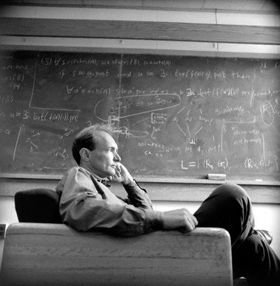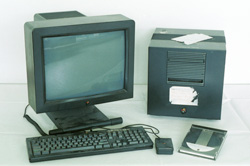Difference between revisions of "Tim Berners-Lee"
m (→Berners-Lee, W3c and Information Ethics) |
m (→Berners-Lee and a Brief History of the World Wide Web) |
||
| Line 7: | Line 7: | ||
---- | ---- | ||
[[File:CERN_Computer.jpg|thumb|alt=A computer that was used by computer scientists at CERN to create browsers and computer code.|In December 1990, Tim Berners-Lee and his colleagues at CERN used this computer to create the first World Wide Web Server.]]<ref>"First World Wide Web (www) server." Science Photo Library. N.p., March 30, 2011. Web. 5 Oct 2011. <http://www.sciencephoto.com/media/349909/enlarge>.</ref> | [[File:CERN_Computer.jpg|thumb|alt=A computer that was used by computer scientists at CERN to create browsers and computer code.|In December 1990, Tim Berners-Lee and his colleagues at CERN used this computer to create the first World Wide Web Server.]]<ref>"First World Wide Web (www) server." Science Photo Library. N.p., March 30, 2011. Web. 5 Oct 2011. <http://www.sciencephoto.com/media/349909/enlarge>.</ref> | ||
| − | In 1991, a few computer scientists released the World Wide Web (WWW) in a lab at CERN. Tim Berners-Lee co-created the World Wide Web (WWW) with a few colleagues on a server-based computer by using the Internet (a medium for sending and receiving files, pictues, text, etc.). He joined multiple webpage together by using the first ever [http://www.w3.org/WhatIs.html hypertext link]. This made possible a “web” of created documents (made through applying computer code, specifically HTML) to be edited and connected on the first, and now outdated, Internet Browser called MOSAIC. After hearing about Berners-Lee’s invention, other companies created improved second-generation browsers could access servers over the Internet. Most of these entities were for-profit organizations. Privatization and capitalism is | + | In 1991, a few computer scientists released the World Wide Web (WWW) in a lab at CERN. Tim Berners-Lee co-created the World Wide Web (WWW) with a few colleagues on a server-based computer by using the Internet (a medium for sending and receiving files, pictues, text, etc.). He joined multiple webpage together by using the first ever [http://www.w3.org/WhatIs.html hypertext link]. This made possible a “web” of created documents (made through applying computer code, specifically HTML) to be edited and connected on the first, and now outdated, Internet Browser called MOSAIC. After hearing about Berners-Lee’s invention, other companies created improved second-generation browsers could access servers over the Internet. Most of these entities were for-profit organizations. Privatization and capitalism is what Berners-Lee was against and he soon took action. The fight for control in a rapidly expanding, and potentially profitable, market was headed by the Netscape browser, who charged their customers to buy their product. This marked the beginning of the [http://sixrevisions.com/web-development/the-history-of-web-browsers/ "browser war."] |
===Berners-Lee, W3c and Information Ethics=== | ===Berners-Lee, W3c and Information Ethics=== | ||
Revision as of 01:35, 6 October 2011
Contents
Tim Berners-Lee's Contribution to Ethics and Information Technology
Tim Berners-Lee, a computer scientist and physicist known for inventing the World Wide Web, is also an individual who has had a successful positive impact on the standards and ethics that have subdued private organizations from monopolizing the World Wide Web, which would have hindered its own competitive innovate development. Even though there were numerous opportunities for Berners-Lee to become quite wealthy from his own creation, Berners-Lee has consistently supported making the World Wide Web (WWW) accessible to everyone, with no single ownership or user fees for its use. Berners-Lee is the founder of the World Wide Web Consortium (W3C) whose mission statement is "To lead the World Wide Web to its full potential by developing protocols and guidelines that ensure long-term growth for the Web."[1]. The individual credited for the invention of the World Wide Web currently drives a 13-year-old Volkswagen Rabbit.[2]
Berners-Lee and a Brief History of the World Wide Web
In 1991, a few computer scientists released the World Wide Web (WWW) in a lab at CERN. Tim Berners-Lee co-created the World Wide Web (WWW) with a few colleagues on a server-based computer by using the Internet (a medium for sending and receiving files, pictues, text, etc.). He joined multiple webpage together by using the first ever hypertext link. This made possible a “web” of created documents (made through applying computer code, specifically HTML) to be edited and connected on the first, and now outdated, Internet Browser called MOSAIC. After hearing about Berners-Lee’s invention, other companies created improved second-generation browsers could access servers over the Internet. Most of these entities were for-profit organizations. Privatization and capitalism is what Berners-Lee was against and he soon took action. The fight for control in a rapidly expanding, and potentially profitable, market was headed by the Netscape browser, who charged their customers to buy their product. This marked the beginning of the "browser war."
Berners-Lee, W3c and Information Ethics
Berners-Lee is the founder and Director of the World Wide Web Consortium(W3C), which is a web standards organization founded in 1994 which develops interoperable technologies to lead the Web to its full potential. [4] The W3C supports the decentralization of information and promotes the use of the WWW as public resource tool. The W3C was partially created for the purpose of deflating any private business whose main objective was to set barriers of entry to the web by charging upfront costs to using their browsers (See Netscape vs. Microsoft 1995).
Acheivements and Awards[5]
Tim Berners-Lee has been rewarded with various accolades for his invention of the WWW and his devotion to its ethical longevity. He has received 15 honorary degrees from various universities. Other awards include:
- 1994-Founded World Wide Web Consortium
- 1995-Kilby Foundations “Young Innovator of the Year” Award
- 1999- First holder of the 3Com Founders chair
- Named “one of the 100 greatest minds of the century” by Time Magazine
- 2004-Knighted “Sir Tim Berners-Lee” by H.M. the Queen for services to the global development of the Internet.
- 2007-Received the Order of Merit by H.M. the Queen
- 2010-UNESCO Niels Bohr Gold Medal Award
Berners-Lee Publications
References
- ↑ <http://www.w3.org/Consortium/mission.html>
- ↑ Wright, Robert. "TIM BERNERS-LEE: THE MAN WHO INVENTED THE WEB - TIME." Breaking News, Analysis, Politics, Blogs, News Photos, Video, Tech Reviews - TIME.com. Time Magazine, May 1997. Web. 05 Oct. 2011. <http://www.time.com/time/magazine/article/0,9171,986354,00.html>.
- ↑ "First World Wide Web (www) server." Science Photo Library. N.p., March 30, 2011. Web. 5 Oct 2011. <http://www.sciencephoto.com/media/349909/enlarge>.
- ↑ Tim, Berners-Lee. "Tim Berners-Lee." W3.org. 01 Sep 2011. Web. 5 Oct 2011. <http://www.w3.org/People/Berners-Lee/>.
- ↑ http://www.w3.org/People/Berners-Lee/Longer.html

